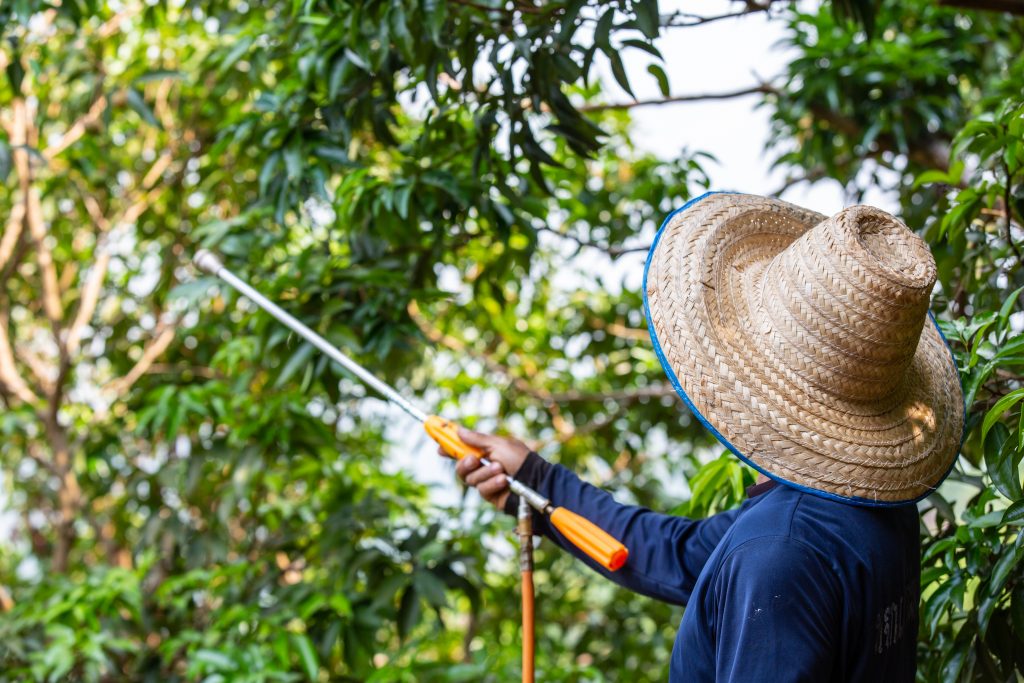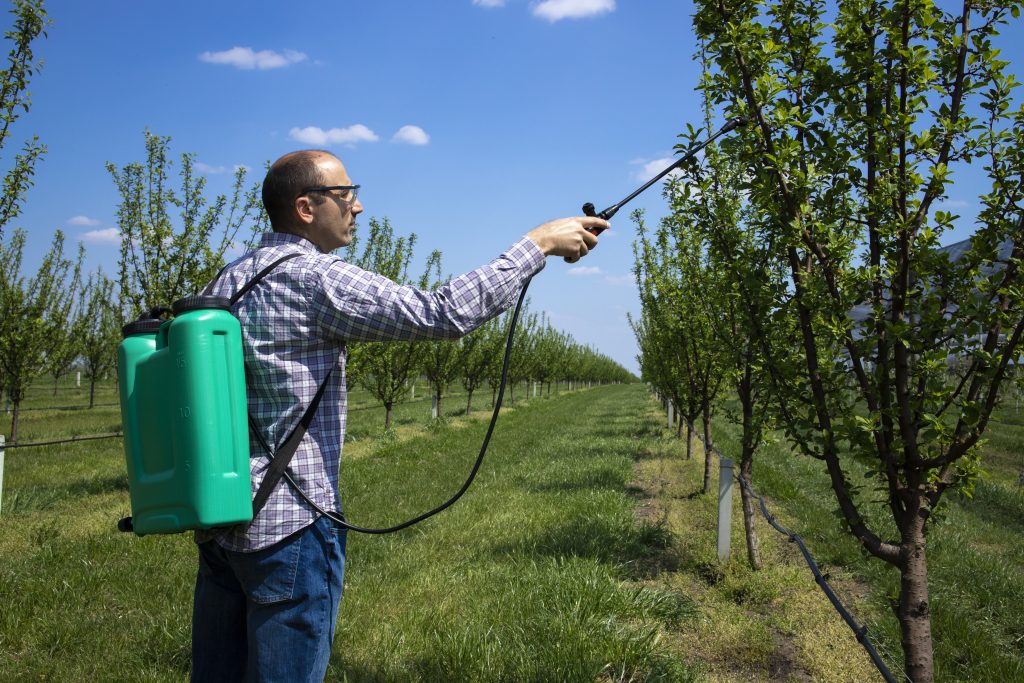THE PROS AND CONS OF USING INSECTICIDES ON TREES
THE PROS AND CONS OF USING INSECTICIDES ON TREES
Understanding the potential benefits and drawbacks of insecticide use in tree care is crucial for making informed and responsible decisions that ensure the health of trees, the environment, and human health. This understanding helps strike a balance between effectively managing tree pests and minimizing the negative impacts of insecticide application. Here’s why it’s important:

- Effective Pest Management: Recognizing the benefits of insecticide use allows for timely and effective management of pest infestations that can otherwise cause irreversible damage to trees. Insecticides can prevent pest outbreaks and protect trees from defoliation, disease transmission, and stress.
- Preserving Tree Health: Understanding the advantages of insecticides helps preserve the health and vitality of trees. Healthy trees are more resilient to environmental stressors, diseases, and secondary pest attacks.
- Mitigating Economic Losses: Insecticide use can prevent economic losses associated with damaged or dying trees. Trees have economic value in terms of aesthetics, property values, and ecosystem services, making their protection worthwhile.
- Rapid Response to Outbreaks: Knowing the benefits of rapid pest control through insecticide use is essential during sudden pest outbreaks. Quick action can prevent widespread infestations that might necessitate more drastic measures later.
- Minimizing Spread of Pests: Insecticides can prevent the spread of invasive pests to other trees, landscapes, or regions. This containment helps protect local ecosystems and prevent the introduction of new pests.
- Balancing Environmental Concerns: Awareness of the potential drawbacks of insecticide use allows for a balanced approach to pest management. It encourages consideration of alternative strategies that minimize harm to non-target species and ecosystems.
- Human Health Protection: Understanding the potential risks of insecticide exposure helps ensure the safety of applicators, residents, and pets. Proper handling, application, and communication reduce health hazards.
- Responsible Environmental Stewardship: Recognizing the environmental impact of insecticides fosters responsible stewardship of natural resources. It encourages consideration of long-term ecological consequences and promotes sustainability.
- Resistance Management: Being aware of the drawbacks of overreliance on insecticides emphasizes the importance of resistance management. Rotating insecticides, using alternative methods, and following integrated pest management (IPM) practices help prevent the development of resistant pests.
- Holistic Pest Management: Understanding the potential benefits and drawbacks of insecticide use is a key aspect of integrated pest management (IPM). IPM promotes a holistic approach that combines various strategies for effective, environmentally friendly, and sustainable pest control.
- Educated Decision-Making: Informed knowledge empowers homeowners, arborists, and landscape professionals to make well-rounded decisions. It enables the selection of the most suitable pest management methods for specific tree species, pests, and environments.
- Public Awareness and Communication: Understanding the complexities of insecticide use encourages effective communication between professionals and the public. It helps convey the rationale behind pest management decisions, building trust and support.
- Legal and Regulatory Compliance: Awareness of the potential benefits and drawbacks of insecticide use ensures compliance with regulations and guidelines set by local authorities. This avoids legal issues and promotes responsible practices.
- Environmental Harmony: A comprehensive understanding of the implications of insecticide use aligns with the goal of achieving a harmonious balance between human activities and the natural environment.
In conclusion, understanding the potential benefits and drawbacks of insecticide use in tree care promotes informed decision-making, responsible environmental stewardship, and the adoption of holistic and sustainable pest management practices. It supports the preservation of tree health, biodiversity, and the overall well-being of ecosystems and communities.
Pros of Using Insecticides on Trees
Using insecticides on trees can offer several benefits in the context of tree care and pest management. While it’s important to carefully consider the potential drawbacks and use insecticides responsibly, there are distinct advantages to their application. Here are some pros of using insecticides on trees:

- Effective Pest Control: Insecticides are designed to target specific pests that pose threats to trees. They can effectively control pest populations, preventing damage and potential loss of trees.
- Prevention of Tree Damage: Insecticides can prevent or minimize the damage caused by insects. This is especially important for pests that feed on leaves, buds, and other tree parts, as damage can weaken trees and make them susceptible to diseases and other stressors.
- Disease Management: Some insecticides have fungicidal properties and can help prevent the spread of diseases carried by insects. By controlling the insect vectors, these products indirectly protect trees from diseases.
- Preservation of Aesthetics: Insecticides can help maintain the visual appeal of trees by preventing defoliation, wilting, and other damage that could detract from their beauty.
- Timely Response to Outbreaks: Insecticides provide a quick and targeted solution to sudden pest outbreaks. They allow for rapid intervention to prevent pests from multiplying and causing extensive damage.
- Protection of Ecosystem Services: Trees provide valuable ecosystem services, such as air purification, shade, and habitat provision. Insecticides can safeguard these services by preventing pest-related damage.
- Minimization of Economic Losses: Preventing or managing pest infestations with insecticides can help avoid economic losses associated with the replacement or restoration of damaged trees.
- Reduced Risk of Secondary Pests: Some pests attract predators or secondary pests that can compound the issue. Using insecticides can break this cycle and prevent the infestation from worsening.
- Local Pest Management: Invasive pests can spread quickly and impact entire ecosystems. Insecticides can help control localized outbreaks, preventing the further spread of pests to new areas.
- Immediate Results: Insecticides often provide relatively quick results. This immediacy can be important for protecting trees from rapid damage.
- Targeted Application: Many modern insecticides are designed to target specific pests, minimizing the impact on non-target species and reducing the risk of harming beneficial insects.
- Potential Cost Savings: Addressing pest infestations promptly with insecticides may be more cost-effective than dealing with extensive damage or tree removal in the long run.
- Integrated Pest Management (IPM): Insecticides are often used as part of an IPM strategy, where they are combined with other methods such as cultural practices, biological control, and monitoring for a comprehensive approach to pest management.
- Preservation of Rare or Valuable Trees: Insecticides can be particularly useful in preserving rare, valuable, or historic trees that might be at risk from pests.
It’s important to note that the effectiveness of insecticides can vary based on factors such as the specific insect species, tree health, application method, and environmental conditions. Professional guidance and a balanced approach that considers both the benefits and potential drawbacks of using insecticides are crucial for responsible tree care.
Cons of Using Insecticides on Trees
Using insecticides on trees can offer benefits for pest management, but there are also potential drawbacks and negative consequences to consider. It’s essential to weigh these cons against the benefits and make informed decisions when using insecticides. Here are some of the cons of using insecticides on trees:

- Environmental Impact: Insecticides can harm non-target organisms, including beneficial insects like pollinators and natural predators. This disruption to ecosystems can have cascading effects on biodiversity and ecosystem health.
- Residue in Soil and Water: Insecticides can leach into soil and water bodies, leading to contamination. This can impact aquatic life, disrupt water ecosystems, and potentially enter the food chain.
- Development of Resistance: Over time, repeated use of the same insecticide can lead to the development of resistant pest populations. This reduces the effectiveness of the insecticide and may require stronger or more toxic treatments in the future.
- Toxicity to Humans and Pets: Some insecticides can be harmful to human health and pets if not applied properly or if exposure occurs. Inhalation, skin contact, or ingestion of insecticides can lead to health risks.
- Non-Selective Impact: Some broad-spectrum insecticides can harm a wide range of insects, including beneficial ones. This disrupts the natural balance of ecosystems and can lead to increased pest problems in the long run.
- Long-Term Environmental Effects: Insecticides can persist in the environment for varying durations, potentially causing unintended harm to non-target species and ecosystems over time.
- Contaminated Runoff: Rainwater can wash away applied insecticides, causing them to enter stormwater runoff. This runoff can carry insecticides into water bodies, affecting aquatic organisms and ecosystems downstream.
- Disruption of Natural Predators: Using insecticides can harm natural predators of pests, disrupting biological control mechanisms that naturally keep pest populations in check.
- Health Concerns for Applicators: People applying insecticides can be exposed to health risks if proper protective measures are not taken. Applicators need to handle insecticides carefully to avoid exposure.
- Limited Long-Term Solutions: Insecticides offer temporary relief from pest infestations but don’t address the underlying causes of the infestation, such as poor tree health or environmental factors.
- Public Perception: The use of insecticides in public spaces can raise concerns among community members who value environmental sustainability, potentially leading to public backlash.
- Regulatory Compliance: The use of certain insecticides may be subject to regulations and restrictions. Proper licensing, training, and adherence to guidelines are necessary to comply with local laws.
- Cost and Financial Implications: The recurring cost of purchasing and applying insecticides can add up over time, especially if infestations persist or return.
- Alternative Pest Management Methods: Relying solely on insecticides can discourage exploration of alternative pest management methods, such as biological control, cultural practices, and tree health improvement.
Balancing the pros and cons of using insecticides requires careful consideration of the specific situation, pest species, tree health, environmental impact, and long-term sustainability. Integrated pest management (IPM) approaches that incorporate a combination of methods are often more effective, environmentally responsible, and sustainable in the long run.
About Murray, Utah
Murray is a city situated on the Wasatch Front in the core of Salt Lake Valley in the U.S. state of Utah. Named for territorial governor Eli Murray, it is the state's fourteenth largest city. According to the 2020 census, Murray had a population of 50,637. Murray shares borders with Taylorsville, Holladay, South Salt Lake and West Jordan, Utah. Once teeming with heavy industry, Murray's industrial sector now has little trace and has been replaced by major mercantile sectors. Known for its central location in Salt Lake County, Murray has been called the Hub of Salt Lake County. Unlike most of its neighboring communities, Murray operates its own police, fire, power, water, library, and parks and recreation departments and has its own school district. While maintaining many of its own services, Murray has one of the lowest city tax rates in the state.
Neighborhoods in Murray, Utah
Murray Oakes, Grant Park, Southwood Park, Murray Park, Murray Park Restrooms, Willow Pond Park, Neighborhood Veterinary Care
Things To Do in Murray, Utah
Bus Stops in Murray, Utah to Truco Services, Inc.
Bus Stop in Murray Central Station (Bay C) Murray, Utah to Truco Services, Inc.
Bus Stop in State St @ 4801 S Murray, Utah to Truco Services, Inc.
Bus Stop in Murray North Station Murray, Utah to Truco Services, Inc.
Bus Stop in State St @ 4949 S Murray, Utah to Truco Services, Inc.
Bus Stop in Murray Central Frontrunner/Trax Station Murray, Utah to Truco Services, Inc.
Bus Stop in Murray Blvd / Vine St (SB) Murray, Utah to Truco Services, Inc.
Bus Stop in State St @ 3925 S Murray, Utah to Truco Services, Inc.
Bus Stop in State St @ 4824 S Murray, Utah to Truco Services, Inc.
Bus Stop in State St @ 5223 S Murray, Utah to Truco Services, Inc.
Bus Stop in Murray Blvd / Allendale Dr (NB) Murray, Utah to Truco Services, Inc.
Bus Stop in Murray Blvd @ 5039 S Murray, Utah to Truco Services, Inc.
Bus Stop in State St @ 4721 S Murray, Utah to Truco Services, Inc.
Driving Directions in Murray, Utah to Truco Services, Inc.
Driving Directions from Woodruff Tree Trimming and Removal to 4640 Commerce Dr, Murray, UT 84107, USA
Driving Directions from Reliable Tree Care to 4640 Commerce Dr, Murray, UT 84107, USA
Driving Directions from Tree Pro-Tech to 4640 Commerce Dr, Murray, UT 84107, USA
Driving Directions from Prestige Tree And Landscape to 4640 Commerce Dr, Murray, UT 84107, USA
Driving Directions from Excellence Tree & Landscape to 4640 Commerce Dr, Murray, UT 84107, USA
Driving Directions from Amen Trees to 4640 Commerce Dr, Murray, UT 84107, USA
Driving Directions from Tim's Tree Care to 4640 Commerce Dr, Murray, UT 84107, USA
Driving Directions from Jordan Tree Service - Murray to 4640 Commerce Dr, Murray, UT 84107, USA
Driving Directions from Arbor Works to 4640 Commerce Dr, Murray, UT 84107, USA
Driving Directions from Diamond Tree Experts to 4640 Commerce Dr, Murray, UT 84107, USA
Driving Directions from Green Tree Arborist to 4640 Commerce Dr, Murray, UT 84107, USA
Driving Directions from TruCo Services to 4640 Commerce Dr, Murray, UT 84107, USA
Reviews for Truco Services, Inc. Murray, Utah
Emily Abercrombie
We had a great experience with TruCo! They were well priced, responsive and prompt. Michael was a pleasure to work with and gave us advice on which plants to put in where we took out our ugly old shrubs. I would highly recommend this company!!!
Michelle Turpin
TruCo Services gets 5 stars from us for customer service. We experienced a few issues with their services this last year and Rob Eccles in senior management, stepped in and immediately handled our issues. He was very committed to making sure they understood our expectations and would execute to make us happy.
Siobhan Billingsley
I work for a property management company and have the pleasure of working with Rob at a community in Sandy. He has been incredible to work with and always responds in a timely manner. He knows all the homeowners by name and address and is aware of all the "problem" areas when it comes to sprinklers. I never have to worry about following up with him because he always reaches out to provide me with an update. If you're looking to work with someone who takes pride in their job, is professional, and can solve the worst landscaping problems thrown your way, Rob is your guy. Thank you, Rob for all you do!
Jaime S.
We have used Truco at 2 of the complexes we manage, they have been great to work with. Good quality service, outstanding customer service with good communication. That's hard to find these days. I highly recommend them. Travis has been awesome to work with.
Jerusha Smart
We use TruCo for a majority of our properties and our home. While other landscaping companies we use come and go for various reasons like cost, communication issues, work performance, etc., TruCo is always consistent in price and work. Also, Rob is the best.

